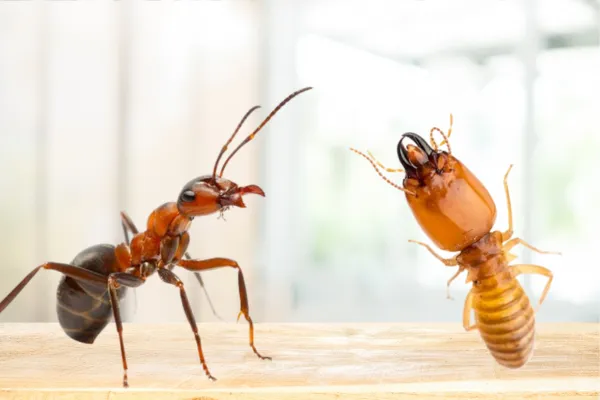
BLOGS
BLOG

What Is The Difference Between Ants And Termites?
Hey there, homeowners! If you've ever dealt with unwelcome guests in your humble abode, chances are you've crossed paths with ants and termites. These pesky critters might seem like two sides of the same coin, but when it comes to pest control, knowing the differences is key to winning the battle. So, let's roll up our sleeves and dive into the world of bug warfare!
Identification Matters
Ants and termites might both have six legs and a knack for invading your space, but they've got distinct features that set them apart. Ants usually sport a slim waist and bent antennae, while termites have a straight waist and straight or slightly curved antennae. Knowing the enemy's appearance is the first step in crafting a battle plan that'll send them packing.
Habitat Hangouts and Nesting Habits
Ants are versatile when it comes to nesting. They'll cozy up in soil, under rocks, or even in the walls of your home. Some like to make a statement with towering mounds in your yard. Termites, on the other hand, are notorious for their love of wood. They'll set up camp in your walls, munching away silently and wreaking havoc on your home's structure. Understanding where these critters call home gives us insight into where to target our pest control efforts.
Social Structure and Colony Dynamics
Ants and termites are social insects, meaning they live in colonies with specialized roles. Ant colonies have queens, workers, and soldiers. The queen's busy laying eggs, while the workers scavenge for food and tend to the nest. Soldiers stand guard, ready to defend their turf. Termite colonies follow a similar setup, with the addition of alates - the winged termites responsible for starting new colonies. Disrupting the delicate balance of the colony can be the key to gaining the upper hand in pest control.
Feeding Habits and Damage Potential
Ants are scavengers, with diets ranging from sweet treats to protein-packed snacks. While they might not directly damage your home, they can still be a nuisance in large numbers. Termites, on the other hand, are the silent destroyers of the insect world. They feast on wood, causing structural damage that can be costly to repair. Recognizing the signs of termite damage early on can save you from major headaches down the line.
Economic and Ecological Impact
Both ants and termites play vital roles in the ecosystem, but when they invade our homes, they become pests. Ants can disrupt agricultural operations and even damage crops, making them a nuisance for farmers. Termites, with their voracious appetites for wood, pose a significant threat to homeowners, causing billions of dollars in damage each year. Balancing pest control efforts with the need to preserve the environment is crucial for maintaining ecological equilibrium.
Control Strategies and Prevention Tactics
When it comes to ant control, sanitation is key. Keep your home clean and food sealed tightly to deter these scavengers. Ant baits and barriers can also help keep them at bay. Termite control requires a more proactive approach. Regular inspections and treatment by pest control professionals can help prevent infestations before they cause serious damage. Installing termite barriers and keeping woodpiles away from your home's foundation are also effective prevention tactics. Integrated pest management (IPM) strategies that combine chemical treatments with cultural and mechanical controls offer the most effective long-term solutions for both ants and termites.
Communication and Defense Mechanisms
Understanding how ants and termites communicate and defend their colonies is crucial for effective pest control. Ants rely on chemical signals called pheromones to communicate and coordinate their activities. By disrupting these communication pathways with bait traps or deterrents, we can disrupt their foraging patterns and limit their presence in our homes. Ants are known for their aggressive defense tactics, with soldier ants equipped with powerful mandibles and sometimes venomous stings. Identifying and targeting these soldiers can weaken the colony's defenses and make them more susceptible to control measures. Termites also communicate using pheromones, but they have additional defense mechanisms such as specialized soldier termites with enlarged heads and mandibles. Chemical barriers and bait stations designed specifically for termites can effectively target and eliminate these destructive pests.
Life Cycle and Reproduction
Understanding the lifecycle and reproductive habits of ants and termites can help anticipate and prevent infestations. Ant colonies reproduce through swarming events, where winged reproductive ants (known as alates) leave the nest to mate and establish new colonies. Monitoring for signs of swarming, such as discarded wings or swarms of flying ants, can indicate the presence of an established colony nearby. Termites also reproduce through swarming, with winged alates leaving the colony to mate and establish new colonies. Termite swarms are often triggered by environmental cues such as temperature and humidity, making early detection and prevention critical for effective control. Targeting and eliminating reproductive individuals during swarming events can disrupt the establishment of new colonies and reduce the overall population of ants and termites in the area.
Environmental Impact and Sustainability
Balancing pest control efforts with environmental sustainability is essential for minimizing the impact on beneficial insects and ecosystems. Integrated pest management (IPM) approaches aim to minimize reliance on chemical pesticides by combining multiple control methods, such as biological control, habitat modification, and cultural practices. By incorporating environmentally friendly pest control techniques, such as using natural predators or barriers to deter ants and termites, we can reduce the need for chemical interventions and minimize the risk to non-target organisms. Educating homeowners and pest control professionals about the importance of sustainable pest management practices can promote the adoption of eco-friendly solutions and reduce the overall environmental footprint of pest control efforts.
Conclusion
In the never-ending battle against household pests, knowledge is power. By understanding the differences between ants and termites and implementing targeted pest control strategies, you can protect your home from these unwanted invaders and enjoy peace of mind knowing your fortress is bug-free. So, arm yourself with knowledge, and let's show those pesky pests who's boss!
© 2024 Valley Wide Pest Control. All rights reserved.

